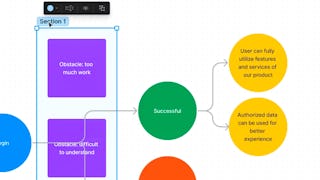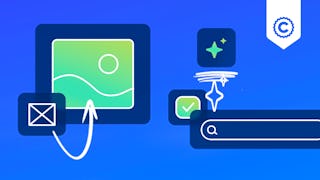Create High-Fidelity Designs and Prototypes in Figma is the fifth course in a certificate program that will equip you with the skills you need to apply to entry-level jobs in user experience (UX) design. In this course, you will follow step-by-step tutorials to learn how to create high-fidelity designs, called mockups, in Figma, a popular design tool. Then, you’ll turn those designs into an interactive prototype that works like a finished product. You’ll conduct research to collect feedback about your designs and make improvements. Finally, you’ll learn how to share your designs with development teams and highlight your work in your professional UX portfolio.


Create High-Fidelity Designs and Prototypes in Figma
本课程是 Google UX Design 专业证书 的一部分

顶尖授课教师
300,989 人已注册
包含在  中
中
您将学到什么
Build mockups and high-fidelity prototypes in the design tool Figma.
Define and apply common visual design elements and principles.
Demonstrate how design systems can be used to organize, standardize, and enhance designs.
Understand the role of design critique sessions and feedback while iterating on designs.
您将获得的技能
要了解的详细信息

添加到您的领英档案
26 项作业
了解顶级公司的员工如何掌握热门技能

积累 Design and Product 领域的专业知识
- 向行业专家学习新概念
- 获得对主题或工具的基础理解
- 通过实践项目培养工作相关技能
- 通过 Google 获得可共享的职业证书

该课程共有5个模块
Turn your focus to visual design, which is how a product or technology appears to users. In this part of the course, you'll start to create mockups, which are high-fidelity designs that represent a final product. To create mockups, you'll use visual design elements, like typography, color, and iconography. Elements are often arranged into layouts using methods like grids, containment, and negative space. You'll apply all of these visual design learnings to build on the mobile app designs you've been working on throughout the certificate program.
涵盖的内容
16个视频23篇阅读材料5个作业3个插件
In this part of the course, you’ll use visual design principles to refine mockups. First, you'll use emphasis to guide users to the most important parts of a page. Next, you'll apply hierarchy, scale, and proportion to organize the elements on each page of your app. Then, you'll consider unity and variety to help elements of your app function together or stand out. Finally, you'll revisit Gestalt Principles, like similarity, proximity, and common region, to help users interpret your designs easily.
涵盖的内容
8个视频11篇阅读材料7个作业1个插件
Come explore the world of design systems! In this part of the course, you'll be introduced to the parts of a design system, as well as the benefits of using a design system. You'll examine various companies' design systems, and you’ll have an opportunity to use them in your own mockups. You'll also learn how to use and create sticker sheets in Figma.
涵盖的内容
9个视频5篇阅读材料4个作业
You’re ready to build high-fidelity prototypes in Figma! Following six steps, you'll turn your mockups into a prototype that's ready for testing. In addition, you'll explore two new concepts, gestures and motion, which can help enrich the user experience and increase the usability of prototypes.
涵盖的内容
9个视频6篇阅读材料5个作业
Now that you have a high-fidelity prototype, it’s time to test your designs. To get started, you’ll conduct a usability study to test your high-fidelity prototype of a mobile app. You'll analyze the feedback you receive to come up with actionable insights and iterate on your designs. Then, you’ll learn how to hand off designs to engineers for production. Finally, you’ll turn everything you’ve learned about user research, ideation, wireframes, designs, and prototypes into a case study for your professional UX portfolio.
涵盖的内容
12个视频12篇阅读材料5个作业
获得职业证书
将此证书添加到您的 LinkedIn 个人资料、简历或履历中。在社交媒体和绩效考核中分享。
位教师

提供方
从 Design and Product 浏览更多内容

Coursera Project Network
 状态:免费试用
状态:免费试用 状态:免费试用
状态:免费试用 状态:免费试用
状态:免费试用
人们为什么选择 Coursera 来帮助自己实现职业发展




学生评论
4,717 条评论
- 5 stars
87.50%
- 4 stars
9.97%
- 3 stars
1.52%
- 2 stars
0.44%
- 1 star
0.55%
显示 3/4717 个
已于 Oct 21, 2023审阅
Amazing content from google, they not only cover figma also they concentrated on UX and other design aspects, Very helpful to build by career. Thank you Coursera & Google.
已于 Oct 18, 2023审阅
I am absolutely delighted with the course I have taken. The course is very intensive, interesting, I received a lot of useful information. I went up another level. Thanks Google!!!
已于 Mar 23, 2021审阅
Working within Figma, you really learn a lot about the program and its benefits. The course teaches you in great detail how to successfully create hifi designs, and is packed with a ton of knowledge.
常见问题
User experience (UX) designers focus on the experience that users have while using products like websites, apps, and physical objects. UX designers make those everyday interactions useful, enjoyable, and accessible. The role of an entry-level UX designer might include coming up with ideas to address user problems, conducting research with users, and designing wireframes, mockups, and prototypes.
If you enjoy talking to and empathizing with people, drawing, thinking creatively, or paying attention to details, a job as a UX designer might be a good fit for you!
This course is the fifth of seven courses that will equip you with the skills you need to apply to entry-level jobs in user experience design. We strongly recommend that you complete the first four courses of the Google UX Design Certificate before completing this one:
- Course 1: Foundations of User Experience (UX) Design
- Course 2: Start the UX Design Process: Empathize, Define, and Ideate
- Course 3: Build Wireframes and Low-Fidelity Prototypes
- Course 4: Conduct UX Research and Test Early Concepts
Alternatively, you should have experience conducting user research in order to empathize with user needs and determine specific user pain points. You also need to have the ability to create personas, user stories, and user journey maps, as well as draft problem statements and value propositions. You need to know how to create wireframes and low-fidelity prototypes on paper and in the design tool Figma. It’s helpful to have experience conducting usability studies and iterating on designs, as well. If you are unfamiliar with any of these topics, they are covered in earlier courses of the Google UX Design Certificate.
Figma and Adobe XD are the design tools taught in the seven courses of the Google UX Design Certificate. This course focuses on creating designs in Figma.
Spreadsheets, word processing applications, and presentation applications will also be used. Throughout the program, you will create a professional portfolio, using the platform of your choice, to showcase your UX design work.
更多问题
提供助学金,



